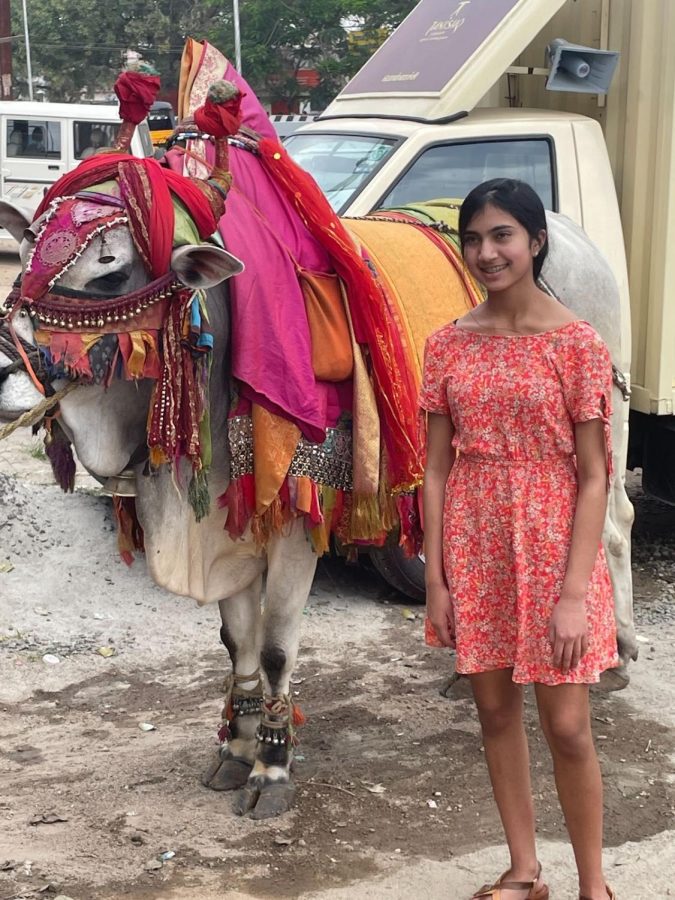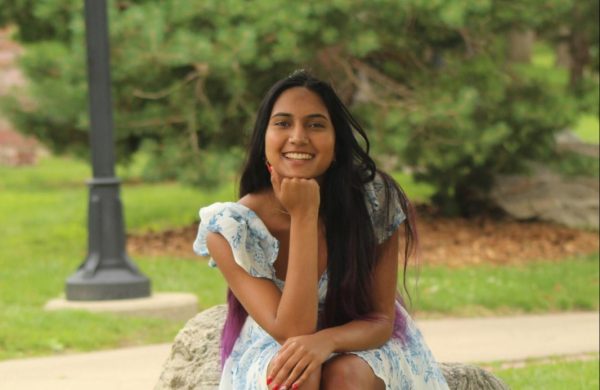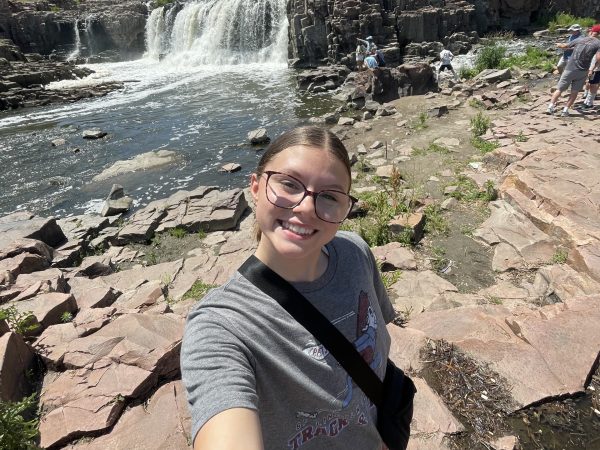When nationality and ethnicity meet
This Ox, called Boom Boom Maadu, decorated in jewelry and fine fabrics, stands in front of stores to bless patrons with good fortune. He was nice, but he tried to run into me a couple of times.
May 12, 2023
In Dec. of 2022, I traveled to India, my parents’ home country, for the second time. If I learned anything from this experience, it would be that despite my appearance, I am not Indian.
Honestly, this discovery didn’t shock me. While I’ve eaten and cooked the numerous dishes native to India, partaken in several cultural practices and gained a basic understanding of our language, I didn’t have a clue what the country was actually like. My parents have almost avoided India like it was the plague, which I guess was sort of true in 2020, but that doesn’t explain why we hadn’t gone in 13 years. My lack of knowledge led to major culture shock, but I was expecting that. India is a very beautiful country but it is very different from what I’m used to and what I was expecting.
Going as a tourist, with hopefully a little more background knowledge on India than the average American visitor, here is a list of the major differences I saw and what you should expect to see if you ever travel to India.
The first major difference I noticed was money. If you try to pay with cash or with credit cards, people will look at you weirdly. Even the street vendors won’t accept cash. They all use mobile banking apps like Google Pay or Paytm. Cash is still printed, but it goes unused outside of places of worship.
While the people of India are busy smart banking, the countless dogs of India are sleeping under parked cars and in front of buildings, hoping that a kind street vendor will throw some meat their way. In South Dakota, we only see a couple of farm cats or the occasional lost dog, but in India, these street dogs are everywhere. From the airport to the mall, even in the dead of night, while the city sleeps, you can hear them barking at each other.
Noise pollution is apparent during the daytime, as the honking of cars can be heard from the time the rooster crows (literally) until dark sweeps the streets. One rule when driving in India: if there is an open space on the road in front of you and 15 cars and 20 motorcycles are all vying for it, whoever honks the most gets the spot. While there are street lines, stop lights and stop signs doing their best to control traffic, no one follows them, making you question why they were made in the first place and how anyone could accomplish such a feat with millions of cars and motorcycles on the street. The roads were unbelievably crowded and a place five miles away would take at least 40 minutes to get to. Despite all of this, car crashes are fairly rare, as drivers in India have learned to be hyper-vigilant, and most people only start learning to drive when they’re 25 years old.
These overcrowded streets do eventually lead to some quiet places. Similar to the U.S., India has several places outside of the city that are completely natural. Most of these areas are hilly forests filled with rivers and wildlife. I was expecting India to be a beautiful country but I was not expecting to find a place that the noise of the city didn’t reach.
The only bad part about going outside is that it is crazy hot in India. I went to India during the winter season and the average daily temperature was 80 degrees Fahrenheit. Even crazier to me, no one wears shorts. It could be boiling hot, which it almost always is, and everyone would still be wearing dress pants, jeans, saris or full-length dresses. Of course, looking back on my trip, the mosquitoes may have been a factor. I wore shorts the entire time I was there and I received several mosquito bites. Even though it’s been five months, I still have the bite marks.
The mosquitoes were fierce but the cows were so cute. We see cows a lot in South Dakota with the amount of farmland here, but in India, cows don’t live on farms. Instead of dogs, people have cows. When going to visit my late grandfather’s friend, I was forced into several pictures with the two cows he and his wife owned. They were so close to the house, it almost felt like they were living in it alongside the humans. Of course, cows, like dogs, roam the streets, but people generally give respect to the cows and offer them lots of food. As a matter of fact, Hindus, at least the ones in my grandmother’s neighborhood, sweep their entryway with cow dung in an effort to preserve auspicious futures.
Lastly, the bathrooms in India were extremely different from the ones in the U.S. I knew this, but I wasn’t really thinking about the different types of bathrooms around the world; so, when I got off my ten-hour flight, it was jarring to walk into a bathroom stall expecting a toilet with toilet paper, and instead see a hole in the ground with a bidet. Of course, quite a few bathrooms had normal toilets, but every single bathroom had a bidet instead of toilet paper. So, if you’re ever traveling to India and don’t know how to use a bidet, bring your own toilet paper.
While noticing all of these cultural differences as a tourist was fun, my main purpose on this trip was to visit my grandma, or Amaye, as I call her, and the hundreds of family members I didn’t even know I had. Being close to my family did make this trip a thousand times better, but India is a genuinely pretty place; though I only saw a tiny part of the country, it was amazing. India is super different from the U.S., but in a good way, and I can’t wait to go visit again soon.









